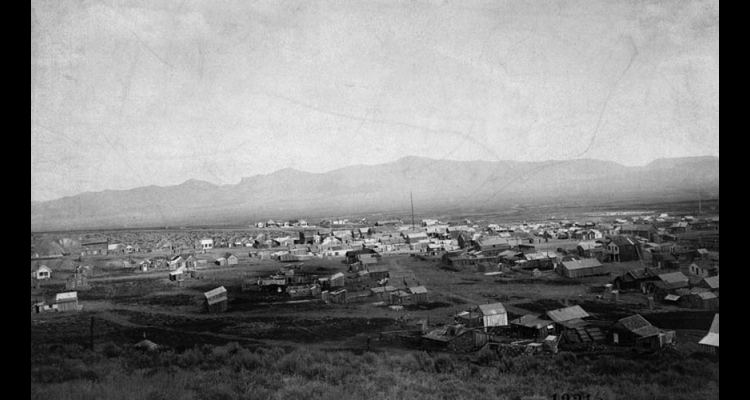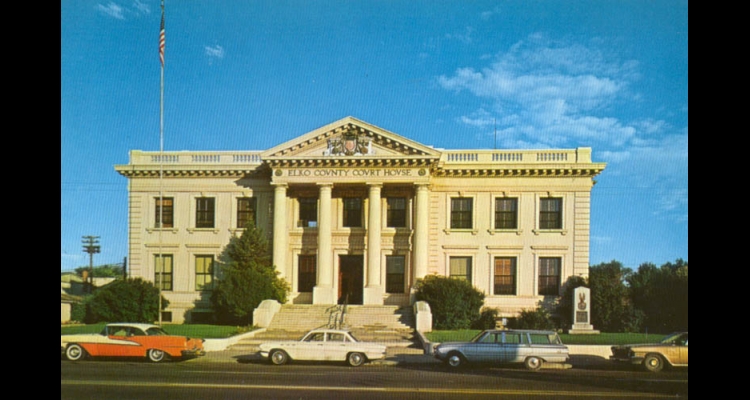Elko
Soon after its founding in 1868, Elko became a critical distribution point for the Central Pacific Railroad in northeastern Nevada, and quickly established itself as the central business hub for desolate Elko County. By February 1869, the budding town supported a rough and rowdy population with over sixty canvas tents. Later that year, Elko was selected as the seat of the county that bears its name. The town grew over time, with shipping, livestock, gaming, and mining as central to its economy. These remain important industries in Elko today.
Soon after its establishment, temporary structures in Elko gave way to a modern town. Just six months after the railroad arrived, Elko supported two banks, forty-five saloons, three hardware stores, eight physicians, and eight attorneys, among many other businesses. With shootings a common occurrence, the town built a much-needed courthouse and jail in December 1869. Just one month later, a school was constructed with an initial enrollment of seventy children. By this time the Central Pacific had completed three freight depots, and the census of 1870 recorded a population of 1,160.
Most modern structures in Elko would last only a year or two before a fire destroyed them in 1871. A brick-making machine was brought in, and many businesses rebuilt on a more permanent basis.
In 1875, the Elko Water and Flour Milling Company opened for business and would soon be responsible for modernizing the town in two important ways. First, the company brought water to Elko's municipal water system via a canal built from the Humboldt River, about nine miles away. Second, in the 1890s, the mill generated the town's first electricity using a power-producing system associated with the milling process.
The University of Nevada was first established in Elko in October 1873, and held its first class of seven students in 1874. The legislature moved the university to Reno in 1885 when Elko's population fell below 1,000.
A sizeable population of Chinese immigrants who worked on the Central Pacific Railroad returned to Elko after they finished the track in 1869. Despite anti-Chinese sentiment at the time, they succeeded in growing and selling vegetables, and made important structural contributions to the town's municipal water system.
Elko's population remained low until 1907, when the construction of the Western Pacific Railroad boosted the economy. Also contributing to the revival were mining camps such as Aura, Edgemont, Gold Creek, Jarbidge, and Midas. Surging prices for commodities, including beef and wool, fortified the ranching industry. The Elko-Lamoille Power Company began construction of a hydroelectric power plant, and by 1915 had delivered alternating current to the town. Street, sewer, and water systems also were modernized, and an airport was developed in 1920 as a mail stop between San Francisco and Salt Lake City. Elko flourished until 1932, when the Great Depression affected the town's economy. Despite the slowdown, Elko's population increased by 877 citizens in the 1930s, and the census of 1940 showed a population of 4,094.
Elko gradually recovered with the moderate successes of its small businesses, the livestock industry, and depression stimulus programs such as the NRA (National Recovery Act) and the WPA (Works Project Administration). The town's real recovery began in 1945, when the state legislature passed a bill that enforced rules governing gaming. Suddenly, portions of gaming revenues were being channeled to infrastructure, contributing to the economy of Elko as well as to the rest of the state.
Gaming contributed to the success of the Commercial Hotel, originally established in 1869 as G. Crocker's Humboldt Lodging House. It was purchased by Newton Crumley, Sr., in 1925. His son, Newton Crumley, Jr., later took on a management role, and in 1937 the pair added a lounge with a seating capacity of 200. The lounge attracted well-known entertainers such as jazz musician Ted Lewis, and drew crowds from as far away as Salt Lake City and Reno. It was the first big-name showroom in Nevada.
Elko's economy remains healthy today, and the town still serves as the business hub for much of northeastern Nevada. The major industry in the town is mining and several major gold companies operate in the area, employing thousands. The Star Hotel—a Basque restaurant—opened in 1910 and remains in business. The Great Basin Community College, which opened in 1967, attracts students from many Nevada counties and several states. The Northeast Nevada Museum showcases the history of the area and continues to draw visitors. In 2006, Elko's population was estimated at over 16,900.
Article Locations
Related Articles
None at this time.
Further Reading
None at this time.

